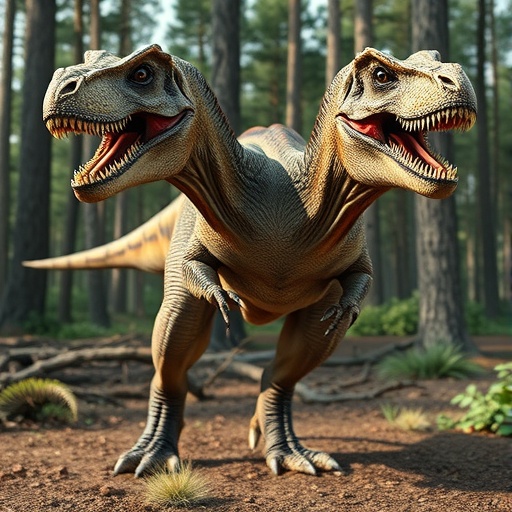The final chapters of the Cretaceous period, a time marked by dramatic shifts in Earth’s biosphere, are yielding new revelations about dinosaur diversity that challenge long-held assumptions. Central to these discoveries is the iconic Tyrannosaurus rex, a species that has long served as a cornerstone for understanding dinosaur paleobiology and ecosystem dynamics during one of Earth’s most profound biological crises. This legendary predator not only anchors much of what we know about non-avian dinosaur extinction patterns but also underpins debates about diversity and evolutionary trajectories in the latest Cretaceous ecosystems.
For decades, the Tyrannosaurus rex has been studied intensively, with thousands of fossils examined to decipher its growth patterns, feeding mechanics, and ecological role. These studies have constructed a vivid picture of its life history and biomechanical prowess, positioning T. rex as one of the most thoroughly examined extinct vertebrates. However, the scientific community has remained divided over the taxonomy of certain smaller, less mature specimens long thought to represent juvenile stages of Tyrannosaurus. These specimens were alternatively classified as a separate genus named Nanotyrannus, igniting intense controversies about dinosaur species diversity, ontogenetic stages, and evolutionary relationships right before the mass extinction event.
A groundbreaking new study introduces an exceptionally well-preserved tyrannosaur skeleton, catalogued as NCSM 40000, discovered in the Hell Creek Formation—one of the most prolific fossil deposits of the late Maastrichtian stage. NCSM 40000 challenges previous taxonomic paradigms, exhibiting anatomical features uniquely shared with the holotype of Nanotyrannus lancensis. By integrating comparative anatomy with innovative longitudinal growth models and newly developed phylogenetic frameworks, researchers have demonstrated that Nanotyrannus is genetically and morphologically distinct from Tyrannosaurus rex, and moreover, that it comprises two species, including the recently described Nanotyrannus lethaeus.
This discovery necessitates a major re-examination of hypotheses constructed around assumed ontogenetic trajectories, which historically posited Nanotyrannus specimens as immature T. rex individuals. The realization that Nanotyrannus represents a distinct genus, and that it existed contemporaneously with T. rex, rewires our understanding of predator diversity during the Maastrichtian and substantially increases the alpha diversity of tyrannosauroids immediately preceding the K-Pg extinction event.
The implications of this dual existence outside the traditional Tyrannosauridae lineage extend far beyond taxonomy. They indicate a more complex ecosystem in which multiple apex predators with differing ecomorphologies coexisted. This points to niche partitioning and resource specialization strategies that sustained a dynamic predatory guild on the eve of mass extinction, suggesting that the decline in dinosaur taxonomic diversity may have been abrupt and more externally forced than previously thought.
Detailed anatomical comparisons reveal that NCSM 40000 and related Nanotyrannus specimens possess a suite of autapomorphies absent in all known Tyrannosaurus rex fossils. These morphological distinctions are robust against ontogenetic variation, underscoring their taxonomic validity rather than representing juvenile characteristics. This overturns the longstanding narrative that smaller tyrannosaurids were merely growth stages of larger taxa and prompts a paradigm shift in interpreting dinosaur fossil assemblages.
The phylogenetic analyses conducted in this study deliberately employed expanded datasets, including novel character matrices specifically tailored to resolve relationships among derived tyrannosauroids. These rigorous analyses place Nanotyrannus outside the traditional Tyrannosauridae clade, redefining the evolutionary tree topology and highlighting a radiation of tyrannosauroids with divergent evolutionary strategies during the latest Cretaceous.
Furthermore, longitudinal growth studies leveraging bone histology and morphometric data fortify the evidence for reaching somatic maturity in Nanotyrannus, independent of comparable Tyrannosaurus growth curves. This careful calibration using ontogenetic markers eliminates the confounding factors of developmental plasticity and ontogenetic variation, which plagued earlier interpretations and led to taxonomic conflations.
The concurrent existence of two distinct tyrannosaur genera in the Hell Creek Formation reveals a rich tapestry of predator-prey dynamics operating within a relatively narrow temporal framework. This cohabitation likely entailed complex ecological interactions, including differential prey selection strategies and habitat partitioning, revealing a sophisticated and highly structured ecosystem continuity until the abrupt cessation imposed by the mass extinction.
Such findings compel a reevaluation of paleoecological models that have traditionally depicted the terminal Cretaceous terrestrial ecosystems as being dominated by singular, large-bodied apex predators. Instead, the presence of two coexisting, morphologically and phylogenetically distinct tyrannosaurids exposes a nuanced landscape of competitive exclusion and coexistence that demands incorporation into future extinction scenario models.
Beyond paleontological taxonomy, the study’s outcome enriches our understanding of evolutionary processes such as speciation, adaptive radiation, and niche differentiation operating amongst dinosaur clades during periods of environmental volatility. This enriches broader evolutionary biology narratives concerning resilience and adaptability in ancient megafaunal communities facing impending global ecological upheavals.
These results underscore the enduring importance of careful specimen-based inquiry bolstered by multidisciplinary analytical frameworks. Only through integrating anatomy, growth modeling, ontogenetic studies, and phylogenetics can paleontologists refine the complex evolutionary histories archived deep within the fossil record, offering critical insights into biodiversity patterns during Earth’s most turbulent times.
As the field moves forward, the revelations about Nanotyrannus and Tyrannosaurus cohabitation invigorate the pursuit of further refined field investigations and novel analytical techniques. This transformative research promises to reshape our comprehension of dinosaur extinction dynamics and extends an invitation for the science community to embrace complexity and nuance in reconstructing Earth’s deep past.
Subject of Research: Paleobiology, taxonomy, and phylogenetic relationships of late Cretaceous tyrannosauroids, focusing on the distinction and coexistence of Nanotyrannus and Tyrannosaurus.
Article Title: Nanotyrannus and Tyrannosaurus Coexisted at the Close of the Cretaceous
Article References:
Zanno, L.E., Napoli, J.G. Nanotyrannus and Tyrannosaurus coexisted at the close of the Cretaceous. Nature (2025). https://doi.org/10.1038/s41586-025-09801-6
Image Credits: AI Generated
Tags: Cretaceous ecosystem dynamicsdinosaur extinction patternsevolutionary relationships among theropodsfossil evidence of Nanotyrannusimplications for dinosaur species classificationLate Cretaceous dinosaur diversityNanotyrannus taxonomy debatenew discoveries in dinosaur researchontogenetic stages in dinosaurspredator-prey interactions in dinosaurssignificance of theropod fossilsTyrannosaurus rex paleobiology





